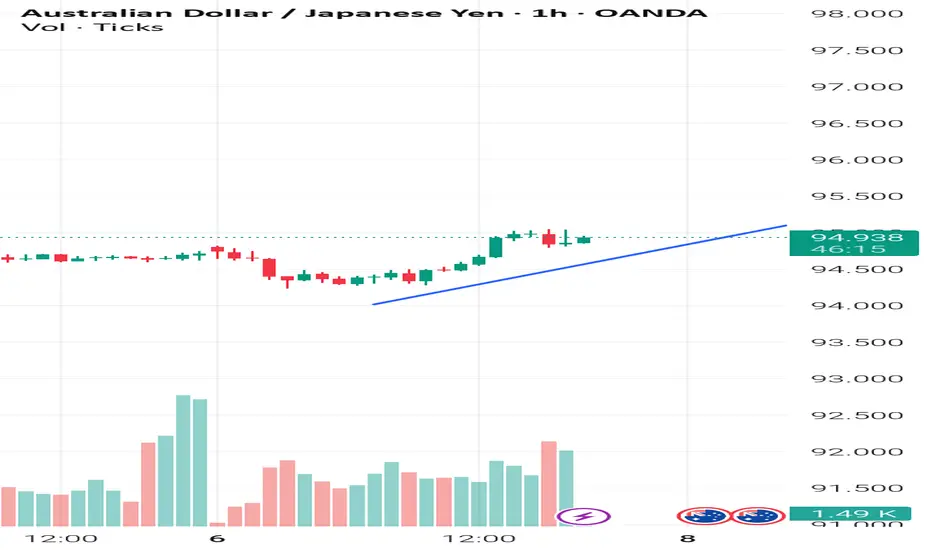It's a week bereft of major US data. In the main it'll be up to the 'risk environment' to determine proceedings (which currently means tariff headlines).
But we do have the RBA and RBNZ rate decisions to potentially create opportunities.
First up, during Tuesday's Asian session is the RBA, a central bank with a preference for high interest rates (hawkish).
*Reminder: (risk environment aside) high interest rates 'generally' equals strong currency.
Analyst concencious is for a 0.25bp cut.
I can envision two scenarios:
A rate cut with 'hawkish narrative' (non or limited cuts on the horizon).
No rate cut (hold), with data dependent forward guidance.
Both scenarios 'should' be AUD positive. Possibly creating another AUD JPY long trade.
Of course, especially after Friday's NFP, we know that anything can happen and the RBA could deliver a 'dovish cut'. But considering inflation is still relatively high in Australia, I would be surprised with that outcome.
And, of course, a lot depends on the overall 'risk environment'. We could very well have 200% tariffs across the board in 12 hours time. And I would only long the AUD in a 'positive risk environment'.
*Side note: With the S&P 'near all time highs', it's only natural that it could pull back a little. So, I'm more focused on the actual narrative at the moment rather than correlations.
**Second side note: I'm slowly starting to revisit the ' buy / sell stop anticipation trade'. And arguably, an 'AUD long' pre-rate decision is viable. (Whereby you place an 'AUD long' stop order pre event, if it's a dovish outcome the order doesn't trigger). It's not something I endorse in a 'live account' but it's a strategy worth considering. Particularly as I suspect 'red flag' US releases could become important moving forward.
Ultimately, no matter the type of trade you take, it's very important to remember that 50% will hit profit and 50% will stop out. That's why we use a higher risk/ reward per trade.
But we do have the RBA and RBNZ rate decisions to potentially create opportunities.
First up, during Tuesday's Asian session is the RBA, a central bank with a preference for high interest rates (hawkish).
*Reminder: (risk environment aside) high interest rates 'generally' equals strong currency.
Analyst concencious is for a 0.25bp cut.
I can envision two scenarios:
A rate cut with 'hawkish narrative' (non or limited cuts on the horizon).
No rate cut (hold), with data dependent forward guidance.
Both scenarios 'should' be AUD positive. Possibly creating another AUD JPY long trade.
Of course, especially after Friday's NFP, we know that anything can happen and the RBA could deliver a 'dovish cut'. But considering inflation is still relatively high in Australia, I would be surprised with that outcome.
And, of course, a lot depends on the overall 'risk environment'. We could very well have 200% tariffs across the board in 12 hours time. And I would only long the AUD in a 'positive risk environment'.
*Side note: With the S&P 'near all time highs', it's only natural that it could pull back a little. So, I'm more focused on the actual narrative at the moment rather than correlations.
**Second side note: I'm slowly starting to revisit the ' buy / sell stop anticipation trade'. And arguably, an 'AUD long' pre-rate decision is viable. (Whereby you place an 'AUD long' stop order pre event, if it's a dovish outcome the order doesn't trigger). It's not something I endorse in a 'live account' but it's a strategy worth considering. Particularly as I suspect 'red flag' US releases could become important moving forward.
Ultimately, no matter the type of trade you take, it's very important to remember that 50% will hit profit and 50% will stop out. That's why we use a higher risk/ reward per trade.
Disclaimer
The information and publications are not meant to be, and do not constitute, financial, investment, trading, or other types of advice or recommendations supplied or endorsed by TradingView. Read more in the Terms of Use.
Disclaimer
The information and publications are not meant to be, and do not constitute, financial, investment, trading, or other types of advice or recommendations supplied or endorsed by TradingView. Read more in the Terms of Use.
